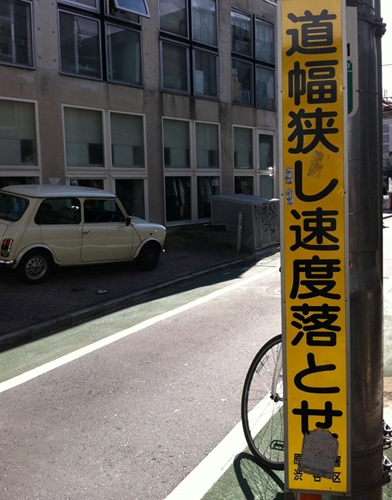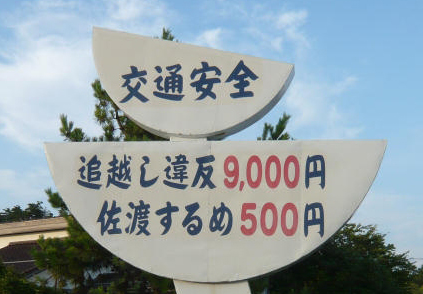162. The "Movement" Radical: 辶 and 辶
The "movement" radical 辶 really gets around. It's no surprise that it appears in scads of kanji, as it's always on the move! However, as you'll see, it puts a strange variety of objects in motion. For example, compare the kanji in each column:
| 道 (188: way) | 首 (139: neck) |
| 速 (534: quick) | 束 (1535: bundle) |
The radical appears to lend mobility to a neck and a bundle respectively! We'll see quite a bit of this pattern.

Photo Credit: Kevin Hamilton
A sign about how to handle a narrow road contains these words:
道幅 (みちはば: width of a road)
狭し (せまし: narrow), shown in an archaic form rather than 狭い
速度 (そくど: speed)
落とす (おとす: to let fall, shown here in the imperative form)
In other words, the road is narrow, so slow down. But how can you do that when two "movement" radicals act here as engines?!
Japanese and English Names of This Radical
In Japanese, we can refer to 辶 as しんにょう. The しん comes from the on-yomi of 進 (すす•む: to advance), which contains this radical. And the にょう indicates that this is an enclosing radical; for more on that topic, go to Radical Terms and see the last parts of the sections "Radical Positions" and "Radical Names."
Some people refer to enclosures as にゅう, so the name しんにゅう also works for this radical.
The Joy o' Kanji preference for an English name is the "movement" radical, but alternatives exist, including "move ahead," "road" (as in 道: road), and "to walk."
Photo Credit: Eve Kushner
As you can see on this lantern on Sado Island (northwest of Honshu), the calligraphic forms of the "movement" radical and the "water" radical 氵 can look similar.
The characters featured here are 近江屋 (おうみや), combining 近江 (おうみ: name of an old province in what is today Shiga Prefecture on Honshu) and 屋 (や: store).
By the way, the "movement" radical also looks like one other:
radical 54: the "long stride" radical, 廴
Both have three strokes and are on the left sides of characters. Furthermore, both indicate movement. Their Japanese names are even similar; one reads 廴 as いんにょう or えんにょう. The えん comes from the on-yomi of 延 (の•びる: stretching), which features this radical. Because 廴 appears in this kanji, some people refer to it as the "stretching" radical.
The Shape of the "Movement" Radical
I said in the last photo caption that 辶 has three strokes, but that actually depends on circumstances.
Sources disagree about how to count the strokes in 辶 and in the variant form 辶. Nelson refers to these as having two and three strokes respectively, but other sources say they have three and four strokes, and Joy o' Kanji shares that view.
However, a font can make it seem as if there are two dots in the top-left corner of the radical, as you can see at the link, which displays two versions of the non-Joyo kokuji 辻 (crossroads). The shape on the right seems to have one extra stroke.
If we're looking at this radical in standard fonts (with just one dot in the upper-left corner), the four-stroke version is rare to see. It does appear, though, in the non-Joyo kokuji 辷, which means "to slip, slide, fail in exams." What a great set of definitions!
By the way, the "movement" radical used to look like 辵. As you can see on Denshi Jisho, this non-Joyo kanji has the yomi of チャク. The shape then evolved into its current, modified form.
Kanji Containing 辶 Plus Another Radical
For no reason that I can discern, the "movement" radical is prone to fun patterns. For instance, several kanji (see the left column below) happen to combine 辶 with other radicals (in the right column):
| 退 (746: to retreat) | 艮 (radical 138: the "stopping" radical) |
| 違 (1006: to differ; violate) | 韋 (radical 178, "tanned leather" radical) |
| 巡 (1374: to make the rounds) | 巛 (radical 47, the "curving river" radical) |
| 逮 (1547: to catch a criminal) | 隶 (radical 171, the "slave" radical) |
| 逐 (1578: one by one; to drive out) | 豕 (radical 152, the "pig" radical) |
The shapes on the right side are not Joyo kanji. And in 巡, the on-duty radical is 巛, rather than 辶.

Photo Credit: Opqr
This sign on Sado Island contains three kanji with "movement" radicals, which makes sense, as it's about driving.
The top part is 交通安全 (こうつうあんぜん: traffic safety), which contains 通 (176). This kanji has quite a few meanings, but the relevant one here is "to pass through."
Then we find these words:
追越し (おいこし: overtaking)
違反 (いはん: violation (of law))
9,000円 (きゅうせんえん: 9,000 yen)
That is, there's a 9,000-yen fine for overtaking cars in areas where that’s prohibited. This definitely seems to issue a stern warning to reckless drivers. However, the next line introduces something you don't normally see on signs from the police department:
佐渡 (さど: name of island)
するめ (鯣: dried squid, where 鯣 is non-Joyo)
500円 (ごひゃくえん: 500 yen)
This indicates that whereas a traffic violation is really expensive, dried squid on Sado is relatively cheap! So if you avoid a fine, you can save 9,000 yen, which will buy you a lot of squid!
Anyway, 追 (350: to chase, pursue, follow) and 違 (1006: to differ; violate) share our radical. The former one combines it with what is almost certainly the representation of a "person's rear," says Henshall, noting that 追 means "to move in pursuit of a person."
He defines the right side of 違 as "opposed feet," saying that it acts phonetically here to express "to part from" and "to move away." Thus, 違 means "to move away from something," which extends to "to differ."
If one kanji has us in hot pursuit and the other is moving away, it's a wonder they ended up in the same sign!
Characters with 辶 Plus a Joyo Kanji That Can Be a Radical
Inside two more characters with the "movement" radical, we find Joyo kanji that also qualify as radicals:
| 近 (103: near) | 斤 (1176: loaf (of bread)), which is radical 69, the "ax" radical |
| 迷 (797: perplexed) | 米 (201: rice), which is radical 119, the "rice" radical |
Photo Credit: Eve Kushner
In this sign in a shop in Narita Airport, the words break down as follows:
雑誌 (ざっし: magazine)
立ち読み (たちよみ: reading while standing (in a bookstore, etc.))
他 (ほか: other)
お客様 (おきゃくさま: customers)
迷惑 (めいわく: trouble, bother)
遠慮 (えんりょ: declining, refraining)
The notice translates as "Reading the magazines while standing bothers other customers, so please refrain." I doubt that a quiet act of reading would truly disturb other patrons, but it would certainly annoy the store owner on two counts. First, the browsers probably have no intention of buying anything. Second, they may block other customers from reaching the magazine stand.
How great, by the way, to have a word for "standing still and reading"!
Anyway, the sign is about stasis, and yet it contains two instances of the "movement" radical: 迷 (797: perplexed) and 遠 (79: distant).
Henshall says that in 迷, the 米 acts phonetically to represent "uncertainty," so it combines with the radical to mean "uncertain movement." That's what happens when one is lost or perplexed.
As for 遠, the 袁 part means "long kimono" but acts phonetically here to express "long," says Henshall. "Long movement" is much the same as "distance," he notes.
Kanji Combining 辶 with a Joyo Character
In many Joyo kanji with the "movement" radical, we find other Joyo characters. Here's what I mean:
| 運 (231: to carry) | 軍 (466: army) |
| 週 (308: week) | 周 (504: periphery) |
| 返 (389: to return) | 反 (371: -anti) |
| 連 (607: link; in succession) | 車 (31: car) |
| 造 (739: to make) | 告 (481: to notify) |
| 遺 (808: to leave behind (at death)) | 貴 (834: noble) |
| 逸 (1010: to let slip) | 免 (1849: exempt) |
| 遮 (1339: to interrupt) | 庶 (1381: many; commoner) |
| 遵 (1380: to obey) | 尊 (927: honor) |
| 逝 (1475: to die) | 折 (522: to break off; fold) |
| 迭 (1627: to replace someone) | 失 (501: to lose) |
| 逃 (1642: to escape) | 兆 (939: omen) |
| 透 (1647: to pass through) | 秀 (1355: excellent) |
| 迫 (1697: to press on, close in) | 白 (65: white) |
| 遜 (2057: humble; inferior) | 孫 (538: descendants, grandchild) |
Can you find relationships between the items in each column? These connections often defy logic!
Photo Credit: Kevin Hamilton
For something fixed in a wall, this sign has a great deal of movement! Here's what I mean. The first word is 送水口 (そうすいこう: water supply pipe inlet-outlet). In the second line we find 連結 (れんけつ: connection), 送水管 (そうすいかん: water main), and -用 (-よう: use, for). All of this indicates that this is the place a firefighter would attach a fire hose.
In addition to an abundance of water, we have a good supply of 辶, as three of the characters (one-third of them!) contain this radical. I'm referring to 送 (331: to send) and 連 (231: to carry).
Kanji Combining 辶 with a Non-Joyo Character
Finally, several Joyo kanji (left column) put the moves on the non-Joyo kanji (right column) tucked inside them:
| 遠 (79: distant) | 袁 (long kimono) |
| 選 (527: to choose) | 巽 (southeast) |
| 過 (629: to pass by; exceed) | 咼 (crooked mouth; dishonest; evil) |
| 逓 (1618: to relay; gradual) | 乕 (brave) |
| 避 (1733: to avoid) | 辟 (crime; false) |
| 遍 (1783: everywhere) | 扁 (level, small) |
| 遡 (2051: to go upstream) | 朔 (first day of the month) |
Photo Credit: Eve Kushner
This stone contains just one instance of the "movement" radical, so clearly it has no power to go anywhere! Here's what it says:
世界 (せかい: world)
遺産 (いさん: heritage)
日光 (にっこう: name of a town in Tochigi Prefecture on Honshu)
社寺 (しゃじ: shrines and temples), a very cool word!
The kanji with "our" radical is 遺 (808: to leave behind (at death)), which has a "noble" interior, 貴 (834: noble).
